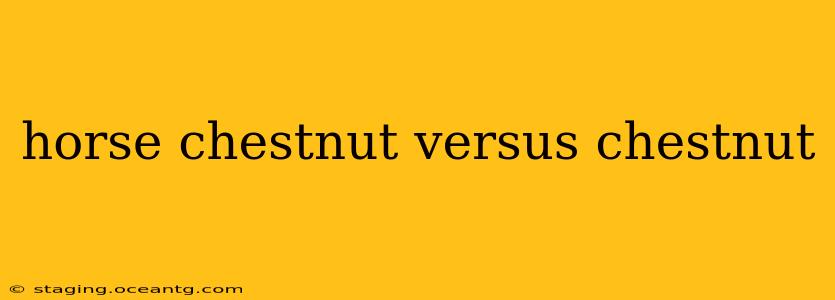The terms "horse chestnut" and "chestnut" are often used interchangeably, leading to confusion. However, these two nuts, while sharing a similar name and appearance, are distinctly different, belonging to separate plant families and having vastly different uses (and edibility!). This article will clarify the key differences between horse chestnuts and chestnuts, addressing common queries and misconceptions.
What is a Horse Chestnut?
The horse chestnut ( Aesculus hippocastanum) belongs to the Sapindaceae family. These trees, with their iconic palmate leaves and spiky seed pods, are frequently planted ornamentally for their striking appearance. The nuts themselves are large, brown, and shiny, often exhibiting a distinctive pale, circular scar.
Crucially, horse chestnuts are poisonous to humans and many animals. They contain aesculin and other compounds that can cause nausea, vomiting, and other gastrointestinal distress if ingested. Therefore, never eat a horse chestnut.
What is a Chestnut?
Chestnuts (Castanea sativa, Castanea dentata, and other species) belong to the Fagaceae family, the same family as oaks and beeches. True chestnuts are edible and have been a staple food source for centuries in many cultures. They're smaller and flatter than horse chestnuts, with a smoother, less shiny surface. They grow inside a spiny burr that contains usually two or three nuts.
What are the Key Differences Between Horse Chestnuts and Chestnuts?
Here's a table summarizing the key distinctions:
| Feature | Horse Chestnut | Chestnut |
|---|---|---|
| Family | Sapindaceae | Fagaceae |
| Edibility | Poisonous to humans and many animals | Edible (cooked) |
| Taste | N/A (inedible) | Sweet and slightly floury when cooked |
| Size & Shape | Larger, rounder, glossy | Smaller, flatter, less glossy |
| Seed Pod | Spiky capsule containing usually one nut | Spiny burr containing 2-3 nuts |
| Uses | Ornamental, some medicinal (external use only) | Food, timber, sometimes used in crafts |
| Leaves | Palmate (finger-like) | Elliptical or lanceolate |
Are Horse Chestnuts Used for Anything?
While inedible, horse chestnuts have found some uses:
- Traditional medicine: Historically, extracts from horse chestnuts have been used topically to alleviate symptoms of venous insufficiency and haemorrhoids. However, scientific evidence supporting these uses is limited, and it's vital to consult a healthcare professional before using any horse chestnut-based remedies.
- Craft projects: Their smooth, shiny appearance makes them suitable for decorative purposes, such as making Christmas decorations or other crafts. However, remember to handle them with care, as the husks can be irritating to the skin for some individuals.
Can you eat chestnuts raw?
No, chestnuts should not be eaten raw. They contain tannins, which give them a bitter and astringent taste. Raw chestnuts can also cause digestive upset. Always cook chestnuts thoroughly before consuming them. Roasting, boiling, or steaming are common methods of preparation.
What are the health benefits of chestnuts?
Chestnuts are a good source of several nutrients, including vitamin C, potassium, and fiber. They are also relatively low in fat and sodium. Moderate consumption as part of a balanced diet can contribute to overall health. However, like any food, moderation is key.
What are the best ways to identify a chestnut tree?
Chestnut trees are typically characterized by their long, elliptical or lanceolate leaves and spiny burrs that contain the edible chestnuts. The bark is often deeply furrowed and the tree can be quite large. However, accurate identification might require expertise, especially when distinguishing between different chestnut species.
This comprehensive guide should help you distinguish between horse chestnuts and chestnuts. Remember, always err on the side of caution and never consume a horse chestnut. If you have any doubts about the type of nut you've found, it's best to leave it alone.
